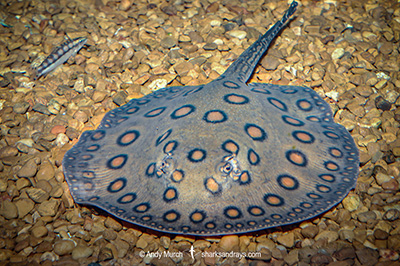Common names
Pearl River Stingray, Pearl Freshwater Stingray. Stingray.
Binomial
Potamotrygon jabuti.
Synonyms
None.
Identification
A medium to large sized freshwater stingray with an oval disc that is slightly longer than wide. Snout broadly rounded with or with a very small central lobe. Eyes pronounced. Spiracle length approximately 2x orbit length. Nostrils thin. Nasal curtain wedge-shaped. Mouth small with 5 oral papillae.
Small to medium sized denticles on central disc. Denticles sparser towards disc margin. Pelvic fin posterior margins slightly posterior to (or level with) disc. Tail shorter than disc width, broad anteriorly, tapering abruptly at base of finfolds. Well developed dorsal/ventral finfolds of equal size. Tail beyond broad anterior section often damaged or absent. One irregular row of tall, sharp thorns dorsally on tail. Tail thorns flanked by numerous smaller thorns in adults. 1-2 large, well developed caudal stings.
Colour
Dorsal pattern of large, bold ocelli on an underlying pattern of light brown and dark brown mottling. Ocelli consist of small golden dots within much larger dark spots, finely ringed in gold. Ocelli smaller towards disc margin. Pelvic fins and base of tail dark with small light brown or yellowish spots. Pattern on small juveniles consist of simpler ocelli.
Ventrum whitish with dark greyish-brown margin. Tail dark posteriorly.
Size
Maximum disc width 48cm. Disc width at birth approximately 10cm.

Conservation Status
NOT ASSESSED
The Pearl River Stingray (Potamotrygon jabuti) has not been assessed by the IUCN. However, all potamotrygonids are facing habitat degradation, fishing pressure, and stress from collection for the aquarium trade.

Habitat
Tropical freshwater lakes and river systems. The pearl river stingray is more common along shallow banks and at the mouth of springs, as opposed to the deeper central troughs of rivers.
Distribution
South America. The Pearl Freshwater Stingray is found in the mid to upper section of the Tapajos River basin. It is common in the Teles Pires River and its tributaries.
Reproduction
Viviparous. 2-3 pups per litter. Gestation period 4 months.
Diet
Diet consists of insects and small fishes.
Behavior
Poorly known. Rests in groups in very shallow water at the mouth of small springs with adequate water flow – personal observation.
Reaction to divers
Easy to approach with non-threatening movements. Will move away but easily followed.
Diving logistics
The best place to snorkel with Pearl River Stingrays is in the clear, spring fed tributaries of the Teles Pires River.
What’s new
View our full list of updates
Similar species
Ocellate Freshwater Stingray (Potamotrygon motoro) Although P. jabuti juveniles are superficially similar, adult pearl whiprays have a more intricate pattern and larger ocelli with proportionately smaller gold centres.









